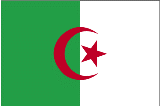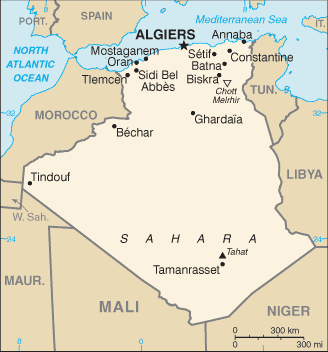|
Algeria
|

|
Capital: Algiers
Population: 43,053,054
Brief History of Algeria:
In ancient times Algeria was known as Numidia. The Numidians were known for their army which rode horses, or cavalry. Later they were called the Berbers. Being on the coast of the Mediterranean Sea, the land of Algeria was part of some of the great Mediterranean empires over the course of history. The land was once under the rule of the powerful empire of Carthage, but was later conquered by the Roman Republic and the Roman Empire. In the 8th century, the Arabs arrived and many Armenians converted to the religion of Islam. Parts of the region managed to maintain their independence for periods of time, but the great empires of the Mediterranean were an important part of the Algerian history.
During the Middle Ages, Algeria was lead by various tribes and Berber dynasties. In the 1500s, the Spanish Empire arrived and took over several cities and settlements. The Ottoman Empire intervened and soon Algeria became part of the Ottoman Empire.
In the 1800s the French invaded Algeria. The battle was brutal and the population of the country declined. However, many French came to settle Algeria. France would rule most of Algeria until the 1900s.
In the mid-1900s the Algerians began to rebel against French rule. The National Liberation Front (FLN) was formed in 1954 and began to fight France. In 1962, Algeria gained its independence and over 1 million French fled the country. For many years after, the country was ruled by a single socialist party that was almost a dictatorship. In the 1990s there was civil war in Algeria. Today there are still many protests in the country with people wanting freedom of speech and improved living conditions.
The Geography of Algeria
Total Size: 2,381,740 square km
Size Comparison: slightly less than 3.5 times the size of Texas
Geographical Coordinates: 28 00 N, 3 00 E
World Region or Continent: Africa
General Terrain: mostly high plateau and desert; some mountains; narrow, discontinuous coastal plain
Geographical Low Point: Chott Melrhir -40 m
Geographical High Point: Tahat 3,003 m
Climate: arid to semiarid; mild, wet winters with hot, dry summers along coast; drier with cold winters and hot summers on high plateau; sirocco is a hot, dust/sand-laden wind especially common in summer
Major cities: ALGIERS (capital) 2.74 million; Oran 770,000 (2009), Constantine, Annaba
The People of Algeria
Type of Government: republic
Languages Spoken: Arabic (official), French, Berber dialects
Independence: 5 July 1962 (from France)
National Holiday: Revolution Day, 1 November (1954)
Nationality: Algerian(s)
Religions: Sunni Muslim (state religion) 99%, Christian and Jewish 1%
National Symbol: star and crescent; fennec fox
National Anthem or Song: Kassaman (We Pledge)
Economy of Algeria
Major Industries: petroleum, natural gas, light industries, mining, electrical, petrochemical, food processing
Agricultural Products: wheat, barley, oats, grapes, olives, citrus, fruits; sheep, cattle
Natural Resources: petroleum, natural gas, iron ore, phosphates, uranium, lead, zinc
Major Exports: petroleum, natural gas, and petroleum products 97%
Major Imports: capital goods, foodstuffs, consumer goods
Currency: Algerian dinar (DZD)
National GDP: $263,300,000,000
** Source for population (2012 est.) and GDP (2011 est.) is CIA World Factbook.
Back to Geography Home Page
